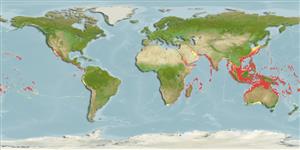>
Anguilliformes (Eels and morays) >
Muraenidae (Moray eels) > Muraeninae
Etymology: Gymnothorax: Greek, gymnos = naked + Greek, thorax, -akos = breast (Ref. 45335).
More on author: Rüppell.
Environment: milieu / climate zone / depth range / distribution range
Ekologi
laut berasosiasi dengan karang; kisaran kedalaman 0 - 150 m (Ref. 1602). Tropical; 35°N - 36°S, 19°E - 77°W
Indo-Pacific: Red Sea and South Africa (Ref. 3257) eastward to the Tuamoto and Austral islands, north to the Ryukyu and Hawaiian islands, south to New Caledonia. Eastern Pacific: Costa Rica, Panama and the Galapagos (Ref. 9324). Southeast Atlantic: South Africa.
Length at first maturity / Size / Weight / umur
Maturity: Lm ?, range 65 - ? cm
Max length : 240 cm TL jantan/; (Ref. 48635)
Duri punggung (Keseluruhan (total)) : 0; duri punggung lunak (Keseluruhan (total)) : 0; Duri dubur: 0; Sirip dubur lunak: 0; vertebrata, bertulang belakang: 132 - 140. Reddish eyes (Ref. 1602). Color yellowish, densely mottled with dark brown; front of head purplish grey; posterior margins of fins yellow-green; gill opening in a black blotch. Juveniles sometimes bright yellow with brown blotches (Ref. 48635).
Along drop-offs (Ref. 48635). Benthic (Ref. 58302). Occurs in coral or rocky areas of reef flats and protected shorelines to seaward reefs. Feeds on cephalopods (Ref. 30573), fishes, and crustaceans (Ref. 89972). Most often appears on the reef after a fish has been speared during daylight. The regularity and promptness of such appearances make it clear that G. flavimarginatus is especially sensitive to stimuli emanating from an injured or stressed fish (Ref. 13550). Eaten in some parts of the Indo-Pacific (Ref. 12484). Minimum depth reported taken from Ref. 128797. Solitary and curious, usually seen with head protruding (Ref 90102).
Life cycle and mating behavior
Kematangan | Reproduksi, perkembang biakan | Pemijahan | telur-telur | Fecundity | Larva
Chen, H.-M., K.-T. Shao and C.T. Chen, 1994. A review of the muraenid eels (Family Muraenidae) from Taiwan with descriptions of twelve new records. Zool. Stud. 33(1):44-64. (Ref. 6934)
Status IUCN Red List (Ref. 130435: Version 2024-1)
ancaman kepada manusia
Reports of ciguatera poisoning (Ref. 4690)
penggunaan manusia
Perikanan: komersial; Akuarium: Komersial
Alat, peralatan
laporan khas
muat turun XML
Sumber internet
Estimates based on models
Preferred temperature (Ref.
123201): 23.7 - 29, mean 27.8 °C (based on 1990 cells).
Phylogenetic diversity index (Ref.
82804): PD
50 = 0.5000 [Uniqueness, from 0.5 = low to 2.0 = high].
Bayesian length-weight: a=0.00035 (0.00024 - 0.00052), b=3.36 (3.25 - 3.47), in cm total length, based on LWR estimates for this species & Genus-body shape (Ref.
93245).
Trophic level (Ref.
69278): 4.2 ±0.72 se; based on food items.
Daya lenting (Ref.
120179): sangat rendah, Waktu penggandaan populasi minimum lebih dari 14 tahun (Preliminary K or Fecundity.).
Fishing Vulnerability (Ref.
59153): Very high vulnerability (90 of 100).
Nutrients (Ref.
124155): Calcium = 14.6 [7.1, 24.7] mg/100g; Iron = 0.341 [0.190, 0.814] mg/100g; Protein = 18.9 [16.6, 21.5] %; Omega3 = 0.0968 [, ] g/100g; Selenium = 74.2 [35.8, 153.4] μg/100g; VitaminA = 38.1 [10.5, 142.9] μg/100g; Zinc = 0.716 [0.484, 1.021] mg/100g (wet weight);
